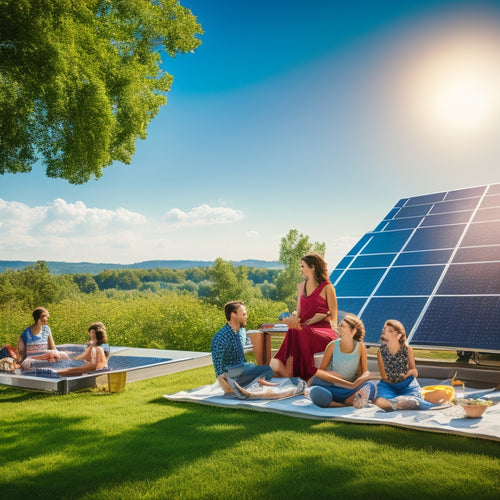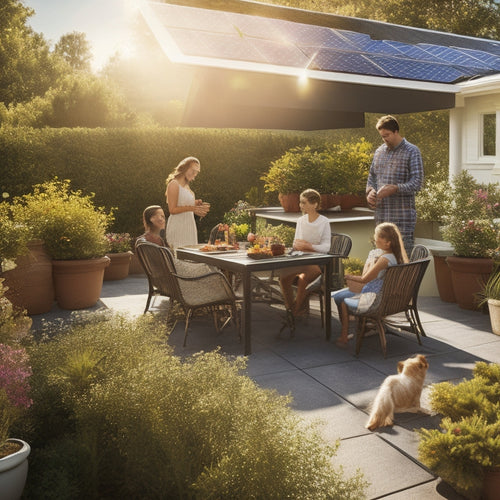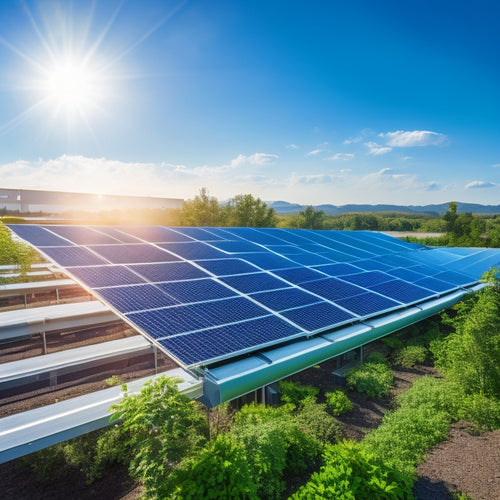
Installing Solar Panels on Buildings: Key Considerations
Share
When installing solar panels on a building, you'll need to maneuver a complex web of considerations. Start by guaranteeing regulatory compliance with local building codes and zoning laws, including assurances of solar access and adherence to aesthetic considerations in historic districts. Next, assess your roof's condition and age, as well as your electrical infrastructure, to determine if upgrades are needed. You'll also need to evaluate your energy consumption and load, and design a system that meets your needs. Finally, consider local incentives and rebates, panel type and installation method, and maintenance and repair planning to guarantee a successful project. By understanding these key factors, you'll be well on your way to a seamless and cost-effective installation that meets your energy goals.
Key Takeaways
- Ensure regulatory compliance with local building codes, zoning restrictions, and historical district considerations to avoid costly delays or project cancellations.
- Assess the roof's condition, material, and structure to determine its compatibility with solar panels and potential need for reinforcement.
- Evaluate energy consumption patterns and load to determine the required solar panel capacity, and consider energy efficiency improvements and seasonal variations.
- Select the right solar panel type, mounting system, and installation method based on factors like orientation, tilt, and shading analysis to optimize energy production.
- Develop a maintenance and repair plan, including regular inspections and performance data analysis, to ensure efficient operation and minimize warranty risks.
Building Code and Zoning Compliance
When starting a solar panel installation project, you must traverse the complex terrain of building codes and zoning regulations.
You'll need to submit a permit application, which will trigger a review of your project against local zoning restrictions. Guaranteeing solar access is critical, as shading from nearby structures can greatly impact energy production.
If your building is located in a historical district, you'll need to comply with additional aesthetic considerations to preserve the area's character. Safety standards must also be met, including structural integrity assessments to verify the roof can support the weight of the solar panels.
Community regulations may dictate specific requirements, such as screening or buffering to minimize visual impact.
It's crucial to research and comply with all applicable regulations to avoid costly delays or even project cancellation. By understanding and addressing these factors early on, you can traverse the complex setting of building codes and zoning regulations, guaranteeing a successful solar panel installation project.
Assessing Roof Condition and Age
Evaluating the roof's condition and age is a critical step in determining its suitability for solar panel installation. You'll need to examine the roof's material, structure, and overall integrity to guarantee it can support the weight and stress of solar panels.
Check for signs of wear, damage, or deterioration, such as cracked or missing tiles, curled or buckled shingles, or rusted flashing. Consider the roof's material compatibility with solar panels; for instance, asphalt shingles may not be suitable for solar installation due to their fragile nature.
You should also inspect the roof's structural integrity, checking for any signs of sagging, unevenness, or water damage. If the roof requires repairs or replacement, factor this into your installation timeline and budget.
In some cases, structural reinforcement options, such as additional beams or supports, may be necessary to guarantee the roof can handle the added weight of solar panels.
Environmental and Climate Factors
Beyond the roof's condition and age, environmental and climate factors play a significant role in determining the feasibility of solar panel installation on your building. You need to take into account the local weather patterns and their potential impact on your solar panels' performance. Areas with high levels of air pollution or frequent shading from trees may not be ideal for solar panel installation.
On the other hand, buildings located in areas with abundant sunlight and low humidity can maximize the benefits of solar energy.
It's crucial to assess the climate impact of your solar panel installation and verify that it aligns with your sustainability practices. By utilizing renewable resources, you can reduce your ecological footprint and contribute to a cleaner environment.
Additionally, take into account the potential effects on local wildlife and take necessary measures to mitigate any negative impacts. By carefully evaluating these environmental and climate factors, you can guarantee a successful and environmentally friendly solar panel installation that supports your goal of reducing your reliance on non-renewable energy sources.
Energy Consumption and Load
You need to evaluate your building's daily energy usage to determine the required solar panel capacity.
This involves analyzing your energy consumption patterns, including peak hour demand, to guarantee the solar panel system can meet your energy needs.
Daily Energy Usage
As you assess your building's viability for solar panels, understanding daily energy usage is essential since it directly impacts the system's required size and capacity.
To enhance energy efficiency, you need to analyze your building's usage patterns, identifying areas where behavioral adjustments can be made to reduce consumption. Installing monitoring systems can provide useful perceptions into historical consumption, helping you pinpoint opportunities for demand response and cost savings.
Seasonal variations in energy usage must also be considered, as they can greatly impact the system's performance. By examining your utility rates and peak savings, you can identify the most cost-effective times to generate and store energy.
A thorough cost analysis will help you determine the ideal system size and capacity to meet your building's energy needs. By understanding your daily energy usage, you can make informed decisions about your solar panel installation, ensuring a system that's customized to your building's unique requirements and maximizes your return on investment.
Peak Hour Demand
What drives your building's energy consumption patterns during peak hours? Understanding peak hour demand is vital when installing solar panels on your building.
Peak hour refers to the period when your building's energy consumption is at its highest, usually during hot summer afternoons or early evenings when lighting, cooling, and other systems are in heavy use.
To develop effective peak hour strategies, it's important to identify the factors contributing to your building's peak demand.
Consider the following:
-
Time-of-use rates: Are you being charged higher rates for energy consumption during peak hours?
-
Cooling and heating loads: Are your HVAC systems consuming more energy during peak hours to maintain a comfortable indoor temperature?
-
Lighting and plug loads: Are your lighting and plug loads, such as computers and appliances, contributing to peak demand?
Panel Type and Installation Method
You'll need to evaluate two critical factors when selecting and installing solar panels: the orientation of the panels and the type of mounting system used.
The orientation of your solar panels has a significant impact on energy production, so you'll want to verify they're positioned to maximize energy output.
You'll also need to choose from a range of mounting system options, including roof-mounted, ground-mounted, and tracking systems, each with its own set of benefits and drawbacks.
Panel Orientation Matters
Optimizing panel orientation is vital to maximize energy output, and it starts with choosing the right panel type and installation method for your building.
You'll need to take into account several factors to guarantee ideal panel alignment, including solar angles, shading analysis, and aesthetic considerations.
To get it right, you should:
- Conduct a thorough shading analysis to identify potential obstructions and adjust panel placement accordingly.
- Take into account seasonal adjustments to account for changes in solar access and temperature effects.
- Opt for tilt optimization to maximize energy production, while also guaranteeing wind resistance and minimal structural impact.
Mounting System Options
When selecting a mounting system, building owners and installers must balance competing demands on panel type and installation method, considering factors like structural integrity, wind resistance, and energy output against aesthetic and budgetary concerns.
You'll need to choose from various rack styles, each with its own set of advantages and limitations. For instance, fixed-tilt racks provide a simple and cost-effective solution, while trackers allow for adjustable installation angles to optimize energy output.
The type of mounting material used also plays an essential role, as it affects weight distribution, wind resistance, and roof compatibility. Aluminum and stainless steel are popular options due to their durability and corrosion resistance.
Aesthetic considerations shouldn't be overlooked, as the mounting system's visual impact can greatly influence the overall appearance of the building.
Additionally, cost implications must be weighed against the benefits of each mounting system option. By carefully evaluating these factors, you can select a mounting system that meets your energy needs while ensuring a safe, efficient, and cost-effective installation.
Inverter and Battery Selection
Selecting the right inverter and battery combination is an essential step in guaranteeing a reliable and efficient solar panel system.
When choosing an inverter, you'll need to take into account inverter compatibility with your solar panel system, as well as the type of inverter that best suits your needs - string inverters, microinverters, or power optimizers.
When it comes to battery selection, you'll want to factor in the following key elements:
-
Battery capacity: Choose a battery with sufficient capacity to meet your energy storage needs, considering your energy usage patterns and the size of your solar panel system.
-
Depth of discharge: Select a battery with a suitable depth of discharge (DOD) to confirm it can handle the desired level of charge and discharge cycles.
-
Compatibility with your inverter: Verify the battery is compatible with your chosen inverter to guarantee seamless integration and maximum system performance.
System Sizing and Configuration
Most solar panel systems require a customized approach to system sizing and configuration to guarantee ideal energy harvesting and efficient energy distribution.
When determining the best system size, you'll need to take into account factors such as your building's energy usage patterns, roof size, and local solar irradiance levels. A correctly sized system guarantees you're generating the right amount of energy to meet your needs, without over- or under-producing.
Configuring your system involves selecting the right combination and layout of solar panels, inverters, and mounting hardware. This is essential for maximizing system efficiency and guaranteeing seamless grid integration.
You'll need to take into account the orientation and tilt of your panels, as well as any potential shading issues, to enhance energy production. Additionally, you should confirm that your system is designed to accommodate future upgrades or expansions.
Electrical Infrastructure Upgrade
With a correctly sized and configured solar panel system in place, you can now focus on guaranteeing your building's electrical infrastructure can support the new power source. This involves evaluating your building's electrical system to identify potential grid connectivity issues and determining the necessary upgrades to support the solar panel system.
Some key considerations for upgrading your electrical infrastructure include:
-
Conducting a load calculation: to determine the maximum amount of power your building's electrical system can handle and identify potential bottlenecks.
-
Upgrading electrical panels and switchgear: to guarantee they can accommodate the increased power output from the solar panel system, which may require additional circuit breakers, fuses, or other components.
-
Installing a grid tie inverter: to convert the DC power from the solar panels to AC power that can be fed into the grid, while also meeting grid connectivity standards and regulations.
Be prepared to factor in upgrade costs, which can vary depending on the scope of the work required.
However, a properly upgraded electrical infrastructure is essential to guaranteeing the safe and efficient operation of your solar panel system.
Maintenance and Repair Planning
You'll need to develop a maintenance and repair plan to guarantee your solar panel system operates efficiently throughout its lifespan.
This plan should include regular inspection schedules to identify potential issues before they become major problems.
Regular Inspection Schedules
How frequently do you plan to inspect your solar panel system to confirm peak performance and prevent potential issues? Regular inspections are vital to guaranteeing your system operates at its best and identifying any problems before they become major issues.
When it comes to inspection frequency, it's important to strike a balance between checking your system often enough to catch any potential problems and not so often that it becomes a burden. A good rule of thumb is to inspect your system every 6-12 months, depending on the size and complexity of your installation.
To make the most of your inspections, create an inspection checklist that includes:
- Visual inspections of the panels and mounting system for signs of damage or wear
- Checks of the electrical connections and wiring for signs of wear or damage
- Verification of the system's performance data to confirm it's meeting expectations
Predictive Maintenance Strategies
Six months into operation, your solar panel system has likely settled into a rhythm, and its performance data can provide useful observations for predictive maintenance strategies.
By leveraging data analytics and predictive algorithms, you can identify potential issues before they become major problems. This proactive approach helps extend equipment lifespan, reduces downtime, and optimizes performance monitoring.
Fault detection is a critical aspect of predictive maintenance, enabling you to schedule maintenance during periods of low energy demand. This strategic approach minimizes the impact on your operations and reduces costs associated with unplanned repairs.
Regular analysis of performance data also helps you identify opportunities for cost reduction, such as optimizing energy output or adjusting maintenance schedules.
Service contracts with your solar panel provider can also be optimized, guaranteeing that maintenance is performed by trained professionals and minimizing the risk of voiding warranties.
Local Incentives and Rebates
Local governments and utilities often offer incentives and rebates to building owners who install solar panels, which can considerably offset the upfront costs of the project. You should research and take advantage of these incentives to maximize your return on investment.
Some incentives to investigate include:
-
Federal tax credits: Claim a percentage of the total installation cost as a tax credit, reducing your taxable income.
-
Utility rebates: Receive a one-time payment or ongoing bill credits from your utility company for installing solar panels.
-
Financing options: Look into special loan programs or grants that can help you cover the upfront costs of installation.
When evaluating local incentives, consider program eligibility, local regulations, and community solar options.
Additionally, examine net metering policies, which allow you to sell excess energy back to the grid and offset your energy bills.
Frequently Asked Questions
Can I Install Solar Panels on a Historic Building?
You'll need to balance energy goals with historic preservation when considering solar panels on a historic building; ascertain you comply with aesthetic guidelines, and consult with local authorities to determine feasible installation options that won't compromise the building's integrity.
Will Solar Panels Void My Roof Warranty?
You'll need to review your roof warranty before installing solar panels, as they might void it; check solar installation regulations and consult with your roofer to understand roof warranty implications and potential modifications to guarantee compliance.
Do Solar Panels Work During a Power Outage?
Ironically, you're probably assuming solar panels will save the day during a power outage, but sadly, they won't - unless you have energy storage. You'll need grid independence to keep the lights on; otherwise, you'll be stuck in the dark like everyone else.
Can I Install Solar Panels on a Metal Roof?
You can install solar panels on a metal roof, leveraging its advantages like durability and water-tightness. Use specialized installation techniques, such as clamps or brackets, to secure panels to the metal roof's standing seams or corrugated ridges.
Are Solar Panels Resistant to Hail Damage?
You'll be relieved to know that solar panels are designed to withstand harsh weather conditions, including hail impact, boasting impressive solar durability. Most modern panels can resist hail damage up to 25mm in diameter, ensuring your energy generation remains uninterrupted.
Conclusion
As you commence on installing solar panels on your building, remember that it's a puzzle with many interconnected pieces. Guarantee each aspect - from code compliance to maintenance planning - fits snugly into place. Like a masterpiece of renewable energy, your solar panel system will shine bright when carefully crafted. By considering these key factors, you'll utilize the power of the sun, reduce your carbon footprint, and reap the benefits of a sustainable future.
Related Posts
-

Solar Power Savings for Environmentally Aware Consumers
Switching to solar power lets you drastically cut your carbon footprint while saving money in the long run. Each kilo...
-

Long-Term Cost Savings With Solar Panels
Investing in solar panels offers substantial long-term savings on energy costs. You'll benefit from federal tax credi...
-

Solar Energy Efficiency Improvements for Businesses
Improving solar energy efficiency for your business can lead to considerable cost savings and enhance your sustainabi...


